belt Lancia Ypsilon 2002 Owner handbook (in English)
[x] Cancel search | Manufacturer: LANCIA, Model Year: 2002, Model line: Ypsilon, Model: Lancia Ypsilon 2002Pages: 191, PDF Size: 2.45 MB
Page 55 of 191

52
G
4)Fold the seat back forwards to
make a flat loading surface with the
boot floor (fig. 78).
If necessary, the cushion can also be
tilted(fig. 79). Consequently, before
releasing the seat back, lift the cush-
ion as shown and tip it against the
front seat backs; the rear seat back-
rest can then be released and tilted
forwards.
To return the seat to its normal po-
sition:
1)Return the seat back to the verti-
cal position and make sure it is prop-
erly locked into place; the red strip on
the hook-up button must disappear.
fig. 77
P4C00034
Removing the parcel shelf
If you wish to remove the parcel
shelf to extend the boot capacity, un-
hook the two tie-rods (one each side)
A (fig. 75)from the hooks B, then
pull the parcel shelf outwards so that
pinsCcome out.
The shelf can then be positioned be-
hind the front seats.INCREASING THE LOAD AREA
Proceed as follows:
1)Make sure that the side seat belts
A (fig. 76)have been inserted into the
corresponding bracket B.
2)Remove the rear head restraints
if required.
3)Release the seat back by pressing
buttonA (fig. 77)(one for each side)
located on the back seat back-rest
(even when a split back seat is fitted);
a red strip will appear on the short
side of the button (towards the inside
of the car) to indicate that it has been
released.
fig. 75
P4C00009
fig. 76
P4C00052
Heavy loads which are
not securely anchored
could seriously injure pas-
sengers in the event of an accident.
4C001-067 ING 11-03-2008 11:57 Pagina 52
Page 56 of 191
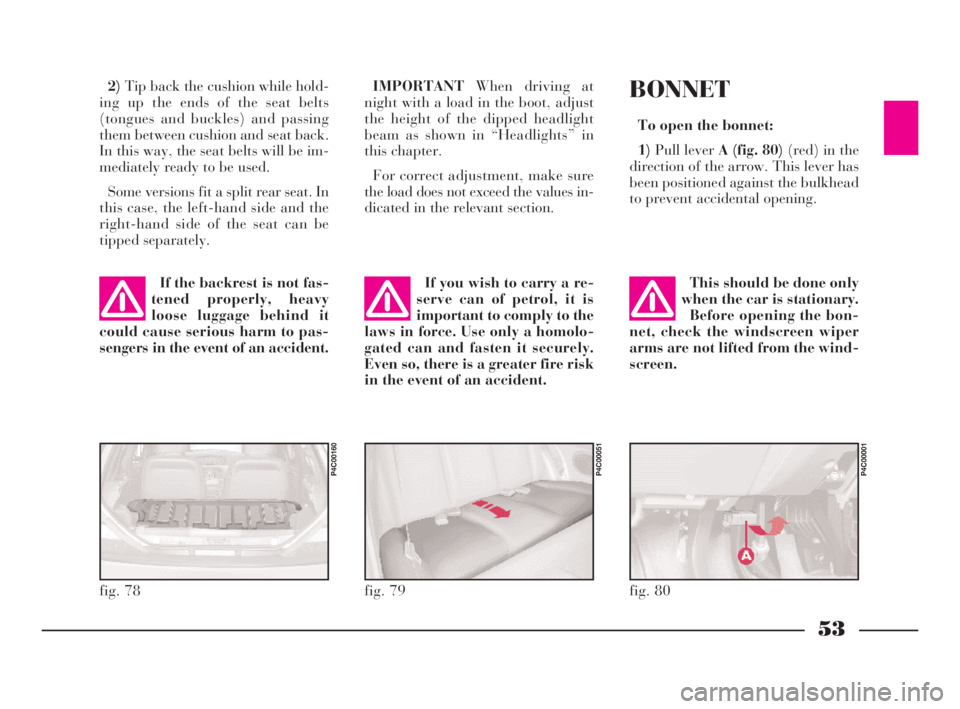
53
G
2)Tip back the cushion while hold-
ing up the ends of the seat belts
(tongues and buckles) and passing
them between cushion and seat back.
In this way, the seat belts will be im-
mediately ready to be used.
Some versions fit a split rear seat. In
this case, the left-hand side and the
right-hand side of the seat can be
tipped separately.IMPORTANTWhen driving at
night with a load in the boot, adjust
the height of the dipped headlight
beam as shown in “Headlights” in
this chapter.
For correct adjustment, make sure
the load does not exceed the values in-
dicated in the relevant section.
fig. 78
P4C00160
fig. 79
P4C00051
If the backrest is not fas-
tened properly, heavy
loose luggage behind it
could cause serious harm to pas-
sengers in the event of an accident.If you wish to carry a re-
serve can of petrol, it is
important to comply to the
laws in force. Use only a homolo-
gated can and fasten it securely.
Even so, there is a greater fire risk
in the event of an accident.
BONNET
To open the bonnet:
1)Pull lever A (fig. 80)(red) in the
direction of the arrow. This lever has
been positioned against the bulkhead
to prevent accidental opening.
fig. 80
P4C00001
This should be done only
when the car is stationary.
Before opening the bon-
net, check the windscreen wiper
arms are not lifted from the wind-
screen.
4C001-067 ING 11-03-2008 11:57 Pagina 53
Page 62 of 191
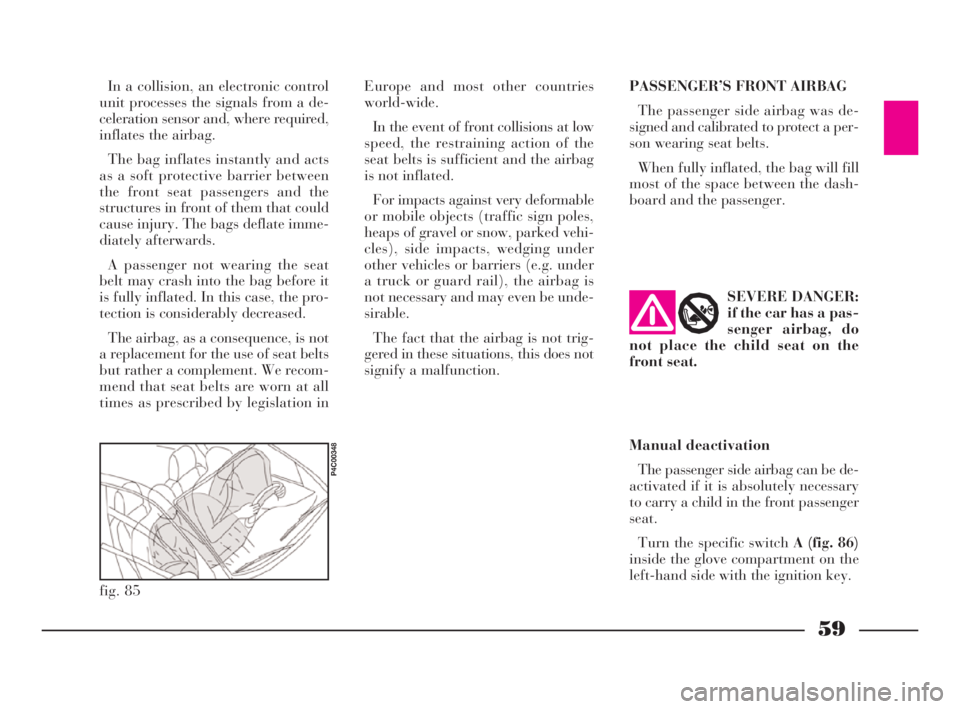
59
G
Europe and most other countries
world-wide.
In the event of front collisions at low
speed, the restraining action of the
seat belts is sufficient and the airbag
is not inflated.
For impacts against very deformable
or mobile objects (traffic sign poles,
heaps of gravel or snow, parked vehi-
cles), side impacts, wedging under
other vehicles or barriers (e.g. under
a truck or guard rail), the airbag is
not necessary and may even be unde-
sirable.
The fact that the airbag is not trig-
gered in these situations, this does not
signify a malfunction.
fig. 85
P4C00348
PASSENGER’S FRONT AIRBAG
The passenger side airbag was de-
signed and calibrated to protect a per-
son wearing seat belts.
When fully inflated, the bag will fill
most of the space between the dash-
board and the passenger. In a collision, an electronic control
unit processes the signals from a de-
celeration sensor and, where required,
inflates the airbag.
The bag inflates instantly and acts
as a soft protective barrier between
the front seat passengers and the
structures in front of them that could
cause injury. The bags deflate imme-
diately afterwards.
A passenger not wearing the seat
belt may crash into the bag before it
is fully inflated. In this case, the pro-
tection is considerably decreased.
The airbag, as a consequence, is not
a replacement for the use of seat belts
but rather a complement. We recom-
mend that seat belts are worn at all
times as prescribed by legislation inSEVERE DANGER:
if the car has a pas-
senger airbag, do
not place the child seat on the
front seat.
Manual deactivation
The passenger side airbag can be de-
activated if it is absolutely necessary
to carry a child in the front passenger
seat.
Turn the specific switch A (fig. 86)
inside the glove compartment on the
left-hand side with the ignition key.
4C001-067 ING 11-03-2008 11:57 Pagina 59
Page 63 of 191
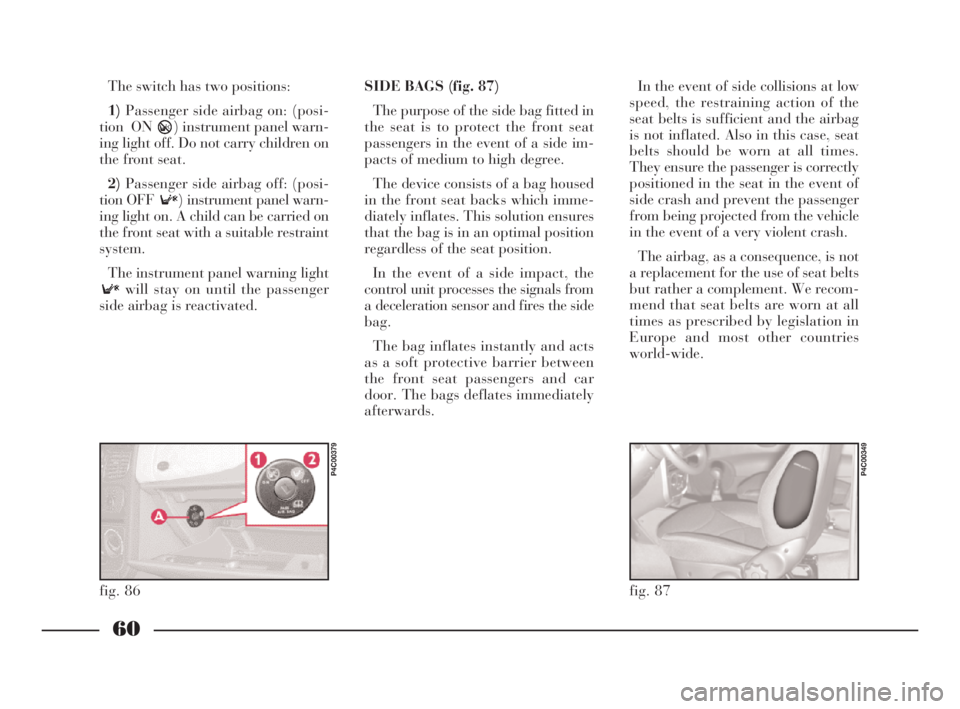
60
G
The switch has two positions:
1)Passenger side airbag on: (posi-
tion ON ) instrument panel warn-
ing light off. Do not carry children on
the front seat.
2)Passenger side airbag off: (posi-
tion OFF ) instrument panel warn-
ing light on. A child can be carried on
the front seat with a suitable restraint
system.
The instrument panel warning light
will stay on until the passenger
side airbag is reactivated. SIDE BAGS (fig. 87)
The purpose of the side bag fitted in
the seat is to protect the front seat
passengers in the event of a side im-
pacts of medium to high degree.
The device consists of a bag housed
in the front seat backs which imme-
diately inflates. This solution ensures
that the bag is in an optimal position
regardless of the seat position.
In the event of a side impact, the
control unit processes the signals from
a deceleration sensor and fires the side
bag.
The bag inflates instantly and acts
as a soft protective barrier between
the front seat passengers and car
door. The bags deflates immediately
afterwards.In the event of side collisions at low
speed, the restraining action of the
seat belts is sufficient and the airbag
is not inflated. Also in this case, seat
belts should be worn at all times.
They ensure the passenger is correctly
positioned in the seat in the event of
side crash and prevent the passenger
from being projected from the vehicle
in the event of a very violent crash.
The airbag, as a consequence, is not
a replacement for the use of seat belts
but rather a complement. We recom-
mend that seat belts are worn at all
times as prescribed by legislation in
Europe and most other countries
world-wide.
fig. 86
P4C00379
fig. 87
P4C00349
4C001-067 ING 11-03-2008 11:57 Pagina 60
Page 64 of 191

61
G
GENERAL WARNINGS
The front and/or side airbags
(where fitted) can be triggered if
the car is subjected to consider-
able crashes or involved in an ac-
cident concerning the underbody
areas, such as a violent impact
against steps, kerbs or projecting
objects fastened to the ground,
falling into large holes or dips in
the road surface.
When the airbag is fired it emits
heat and a small amount of pow-
der. This is not harmful and does
not indicate the beginning of a fire.
Furthermore, the surface of the in-
flated bag and in the passenger
compartment may be covered with
a powdery residues. This powder
may irritate skin and eyes. In the
event of exposure, wash with mild
soap and water.
Go to a LANCIA Dealership as
soon as possible if the warning
light
ûcomes on when travelling
(to signal a fault) to have the prob-
lem repaired. The airbag system is guaranteed
for ten years. Contact a LANCIA
Dealership as the expiry data ap-
proaches.
After an accident which triggered
the airbags, go to a LANCIA Deal-
ership to have the entire safety sys-
tem, the electronic control unit, the
seat belts and the pretensioners re-
placed. The Dealership will also
check the intactness of the electri-
cal system.
Any diagnostic, repair or re-
placement operations concerning
the airbag system must exclusively
be carried out at a LANCIA Deal-
ership.
If you are having the car
scrapped, have the airbag system
deactivated at a LANCIA Dealer-
ship first.
If the car changes hands, the new
owner must be made aware of the
indications given above and be
given this Owner Handbook.The pretensioners (if electroni-
cally controlled), front airbags and
side airbags are activated by the
electronic control unit according
to the type of impact. Conse-
quently, missed activation of one
or more system components does
not indicate a fault in the system.
The instrument panel
warning light ûshould
come on when the ignition
key is turned to MAR and go out
after approximately four seconds.
Immediately contact a LANCIA
Dealership if the warning light ei-
ther does not come on or stays on
or comes on when travelling.
4C001-067 ING 11-03-2008 11:57 Pagina 61
Page 65 of 191
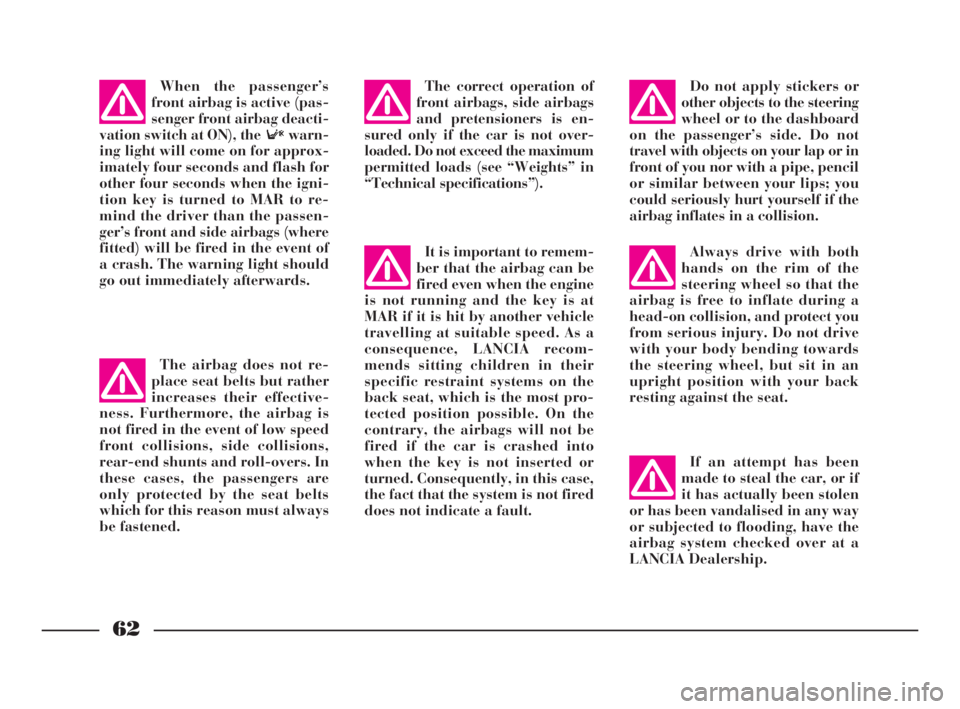
62
G
It is important to remem-
ber that the airbag can be
fired even when the engine
is not running and the key is at
MAR if it is hit by another vehicle
travelling at suitable speed. As a
consequence, LANCIA recom-
mends sitting children in their
specific restraint systems on the
back seat, which is the most pro-
tected position possible. On the
contrary, the airbags will not be
fired if the car is crashed into
when the key is not inserted or
turned. Consequently, in this case,
the fact that the system is not fired
does not indicate a fault.Always drive with both
hands on the rim of the
steering wheel so that the
airbag is free to inflate during a
head-on collision, and protect you
from serious injury. Do not drive
with your body bending towards
the steering wheel, but sit in an
upright position with your back
resting against the seat.
If an attempt has been
made to steal the car, or if
it has actually been stolen
or has been vandalised in any way
or subjected to flooding, have the
airbag system checked over at a
LANCIA Dealership. Do not apply stickers or
other objects to the steering
wheel or to the dashboard
on the passenger’s side. Do not
travel with objects on your lap or in
front of you nor with a pipe, pencil
or similar between your lips; you
could seriously hurt yourself if the
airbag inflates in a collision.
The correct operation of
front airbags, side airbags
and pretensioners is en-
sured only if the car is not over-
loaded. Do not exceed the maximum
permitted loads (see “Weights” in
“Technical specifications”).When the passenger’s
front airbag is active (pas-
senger front airbag deacti-
vation switch at ON), the warn-
ing light will come on for approx-
imately four seconds and flash for
other four seconds when the igni-
tion key is turned to MAR to re-
mind the driver than the passen-
ger’s front and side airbags (where
fitted) will be fired in the event of
a crash. The warning light should
go out immediately afterwards.
The airbag does not re-
place seat belts but rather
increases their effective-
ness. Furthermore, the airbag is
not fired in the event of low speed
front collisions, side collisions,
rear-end shunts and roll-overs. In
these cases, the passengers are
only protected by the seat belts
which for this reason must always
be fastened.
4C001-067 ING 11-03-2008 11:57 Pagina 62
Page 66 of 191

63
G
Do not cover the seat
backs in cars with side
bags.The airbag does not re-
place seat belts but rather
increases their effective-
ness. Furthermore, the airbag is
not fired in the event of low speed
front collisions, side collisions,
rear-end shunts and roll-overs. In
these cases, the passengers are
only protected by the seat belts
which for this reason must always
be fastened.
Do not wash the seat
back in cars with side
airbags with pressurised
steam or water in automatic seat
washing stations.
EOBD SYSTEM
The EOBD (European On Board Di-
agnosis) system fitted in this car com-
plies with Directive 98/69/CE (EURO
3).
This system continuously monitors
the vehicle emission system compo-
nents. Furthermore, the system warns
the driver of deterioration concerning
the emission system components by
means of the warning light on the
instrument panel.
The objective is to:
– monitor system efficiency;
– warn when failures can increase
emissions over the threshold estab-
lished by the European regulations;
– warn of the need to replace deteri-
orated components.
Furthermore, the system is equipped
with a connector for interfacing with
specific tools used to read the error
codes stored in the control unit mem-
ory along with a set of diagnostic and
engine specific parameters.
IMPORTANTAfter eliminating the
problem, your LANCIA Dealership
will run a bench test to fully check the
system. In some cases, a long road test
may be required.Contact a LANCIA Deal-
ership as soon as possible
if the warning light ei-
ther does not come on when the
key is turned to MAR or comes on,
with fixed or flashing light, when
travelling.
4C001-067 ING 11-03-2008 11:57 Pagina 63
Page 78 of 191
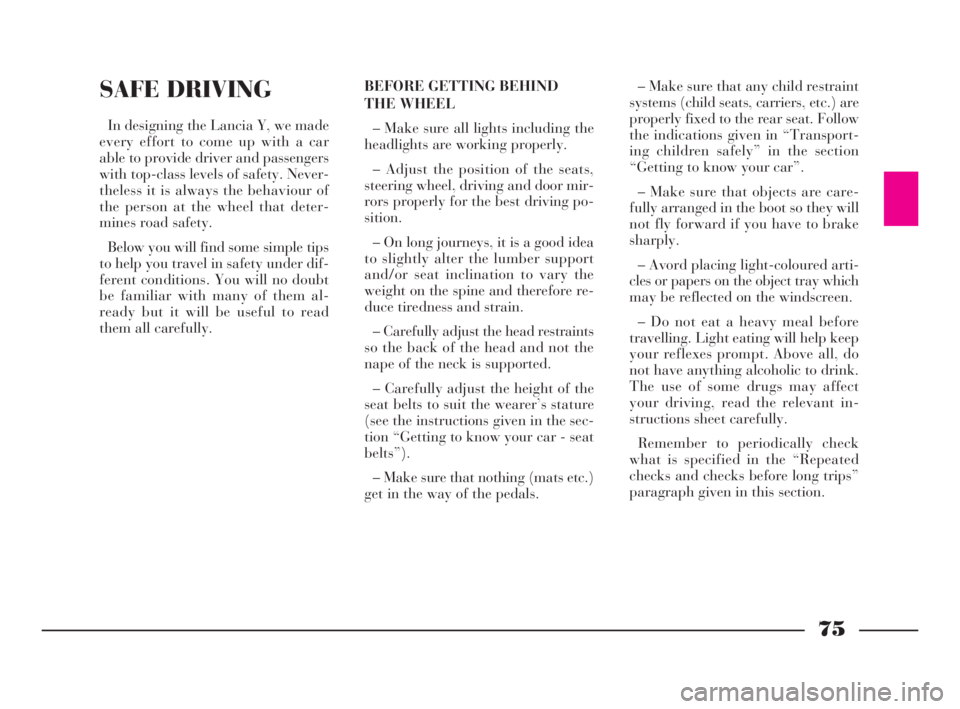
75
G
SAFE DRIVING
In designing the Lancia Y, we made
every effort to come up with a car
able to provide driver and passengers
with top-class levels of safety. Never-
theless it is always the behaviour of
the person at the wheel that deter-
mines road safety.
Below you will find some simple tips
to help you travel in safety under dif-
ferent conditions. You will no doubt
be familiar with many of them al-
ready but it will be useful to read
them all carefully.BEFORE GETTING BEHIND
THE WHEEL
– Make sure all lights including the
headlights are working properly.
– Adjust the position of the seats,
steering wheel, driving and door mir-
rors properly for the best driving po-
sition.
– On long journeys, it is a good idea
to slightly alter the lumber support
and/or seat inclination to vary the
weight on the spine and therefore re-
duce tiredness and strain.
– Carefully adjust the head restraints
so the back of the head and not the
nape of the neck is supported.
– Carefully adjust the height of the
seat belts to suit the wearer’s stature
(see the instructions given in the sec-
tion “Getting to know your car - seat
belts”).
– Make sure that nothing (mats etc.)
get in the way of the pedals.– Make sure that any child restraint
systems (child seats, carriers, etc.) are
properly fixed to the rear seat. Follow
the indications given in “Transport-
ing children safely” in the section
“Getting to know your car”.
– Make sure that objects are care-
fully arranged in the boot so they will
not fly forward if you have to brake
sharply.
– Avord placing light-coloured arti-
cles or papers on the object tray which
may be reflected on the windscreen.
– Do not eat a heavy meal before
travelling. Light eating will help keep
your reflexes prompt. Above all, do
not have anything alcoholic to drink.
The use of some drugs may affect
your driving, read the relevant in-
structions sheet carefully.
Remember to periodically check
what is specified in the “Repeated
checks and checks before long trips”
paragraph given in this section.
4C068-089 ING 11-03-2008 11:59 Pagina 75
Page 79 of 191

76
G
Consider the space re-
quired by extra mats: even
a small problem to the
braking system may indicate addi-
tional brake pedal stroke is re-
quired with respect to normal.
Water, ice and salt sprin-
kled on the road deposit
on the brake disc and re-
duce effectiveness the first time
you brake.
WHEN TRAVELLING
– The first rule of safe driving is pru-
dence.
– Prudence also means putting your-
self into a position where you can pre-
dict wrong or imprudent behaviour
from other drivers.
– Stick closely to the rules of the
road in the particular country where
the car is being driven and, above all,
do not exceed speed limits.
– Ensure that, besides yourself, all
the other passengers in the car have
their seat belts fastened, that children
are sitting in the appropriate child
seats and any animals are in special
compartments.
– You should be physically fit and
mentally alert before setting out on
long journeys.Driving when you are not
mentally alert, drunk, un-
der the influence of drugs
or certain medicines is dangerous
both for you and other road users.
Always fasten both front
and back seat belts in-
cluding child seat seat belt
if fitted. Travelling with the seat
belts unfastened increases the risk
of injury or death if you are in a
collision.
Pay attention when in-
stalling additional spoil-
ers, alloy wheel rims and
caps that are not standard. They
could reduce the brake ventilation
and as a consequence, the braking
efficiency if you brake suddenly
and repeatedly, or when driving
downhill.Do not drive with objects
on the floor in front of the
driver’s seat. Objects
could get stuck under the pedals
making accelerating and braking
impossible.
4C068-089 ING 11-03-2008 11:59 Pagina 76
Page 121 of 191

118
fG
– Call the emergency services mak-
ing the information you give as accu-
rate as you can. On the motorway use
the special column-mounted emer-
gency phones.
– Remove the ignition keys of the ve-
hicles involved.
– If you can smell petrol or other
chemicals, do not smoke and make
sure all cigarettes are extinguished.
– Use a fire extinguisher, blanket,
sand or earth to put out fires no mat-
ter how small they are. Never use
water.
– In pile-ups on the motorway, par-
ticularly when the visibility is bad,
there is a high risk of other vehicles
running into those already immobile.
Get out of the car immediately and
take refuge behind the guard rail.IF ANYONE IS INJURED
– Never leave the injured person
alone. The obligation to provide as-
sistance exists even for those not di-
rectly involved in the accident.
– Do not congregate around the in-
jured person.
– Reassure the injured person that
help is on its way and will arrive soon.
Stay close by to calm him/her down
in case of panic.
– Unfasten or cut seat belts holding
injured parties.
– Do not give an injured person any-
thing to drink.
– Never move an injured person ex-
cept in the following cases.
– Pull the injured person from the
car only if it risks catching fire, it is
sinking in water or is likely to fall over
a cliff or similar. Do not pull his/her
arms or legs, never bend the head
and, as far as possible, keep the body
horizontal.FIRST-AID KIT
The first-aid kit must at least con-
tain(fig. 45):
– sterile gauze for covering and
cleansing wounds
– bandages of different widths
– antiseptic plasters of different sizes
– a roll of plaster
– a packet of cotton wool
– a bottle of disinfectant
– a packet of paper handkerchiefs
– a pair of scissors with rounded tips
– a pair of pincers
– two haemostatic loops.
4C090-119 ING 13-03-2008 12:51 Pagina 118